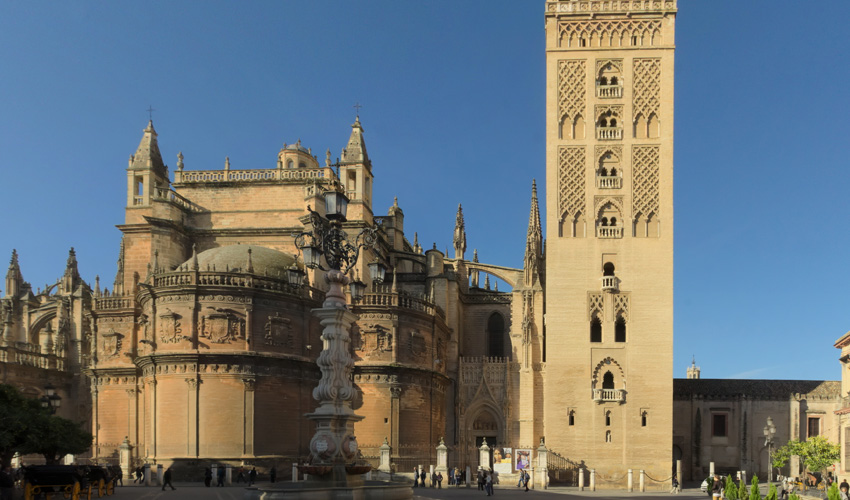Seville

This is the largest tourist destination in southern Spain, and home to many attractions. The cathedral here, adorned with a Moorish bell-tower, is the third largest church in the world by some measurements, though some say the world’s largest by measurement of volume. A host of museums, ancient architecture, palaces and churches are available to explore in Seville, along with the usual big-city amenities of excellent food and cultural activities. One fun must-see here is the diary of Christopher Columbus, which is housed in the Museum of the Indies. Finally, a two-week visit here in April can be amazing- the somber Santa Semana (holy week) and celebratory Feria de Abril that follows is a world-renowned celebration.
Seville is a city that leaves its mark, and many people define it as special. It might be because of the grandeur of its monuments. Or perhaps the charm of areas such as Triana.
It may possibly be the scent of jasmine in its squares or the Spanish guitar music of its streets. Some say that it’s the tradition of its festivals, and many are convinced its tapas are the real reason.
Seville is much more than its undeniable monumentality. It is a city of lively streets and large open spaces such as the huge Plaza de España, María Luisa Park or the avant-garde Metropol Parasol. And if you want to enjoy the authentic atmosphere of Seville, try going for tapas in the old town, in popular areas such as Alameda, Macarena, Nervión, Los Remedios or Triana. Marinated ‘pescaíto’ (fish), small filled rolls, typical snails, fino (white wine), manzanilla (sweet wine) or a cold beer are a must on any tapas outing.
The tradition of Seville is also reflected in its more international festivals. Two good examples are the April Fair and Holy Week. The first is all about joy and passion for popular Andalusian art, an unbeatable chance to enjoy the sound of the Spanish guitar, flamenco fashion and festive Seville. Holy Week is a passionate festival full of emotional moments. To understand it, the best option is to witness one of the much-visited religious processions or hear a live ‘saeta’ (emotional flamenco song dedicated to the religious figures).
Seville is a city that leaves its mark, and many people define it as special. It might be because of the grandeur of its monuments. Or perhaps the charm of areas such as Triana.
It may possibly be the scent of jasmine in its squares or the Spanish guitar music of its streets. Some say that it’s the tradition of its festivals, and many are convinced its tapas are the real reason.
A monumental city
You can see it for yourself in the few metres that separate the Giralda tower, the Cathedral and the Real Alcázar of Seville. La Giralda is a city icon and one of its main charms lies in its viewpoint. The views of Seville are fantastic with its courtyards of orange trees, typical in Andalusia, and a close-up of the largest Gothic temple in Europe, the Cathedral. A visit to the Real Alcázar reveals an extraordinary palace full of details. If you visit in the summer, take advantage of the night visits and the festival held in its gardens.Seville is much more than its undeniable monumentality. It is a city of lively streets and large open spaces such as the huge Plaza de España, María Luisa Park or the avant-garde Metropol Parasol. And if you want to enjoy the authentic atmosphere of Seville, try going for tapas in the old town, in popular areas such as Alameda, Macarena, Nervión, Los Remedios or Triana. Marinated ‘pescaíto’ (fish), small filled rolls, typical snails, fino (white wine), manzanilla (sweet wine) or a cold beer are a must on any tapas outing.
Popular tradition of the south
In Seville, tradition is always in fashion. From flamenco shows and Spanish guitar music to typical ceramics and crafts, which are always a good souvenir of the city. There are plenty of shops and workshops in Triana. And it’s easy to enjoy flamenco at one of the many ‘tablaos’ or neighbourhood ‘peña’ groups. In fact, Seville hosts what is perhaps the most important international festival of this art: The Biennial.The tradition of Seville is also reflected in its more international festivals. Two good examples are the April Fair and Holy Week. The first is all about joy and passion for popular Andalusian art, an unbeatable chance to enjoy the sound of the Spanish guitar, flamenco fashion and festive Seville. Holy Week is a passionate festival full of emotional moments. To understand it, the best option is to witness one of the much-visited religious processions or hear a live ‘saeta’ (emotional flamenco song dedicated to the religious figures).

 Spanish
Spanish German
German Dutch
Dutch